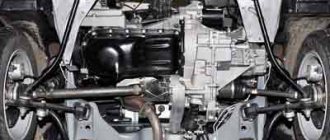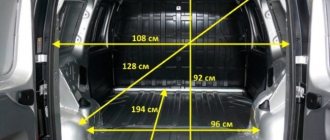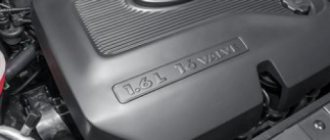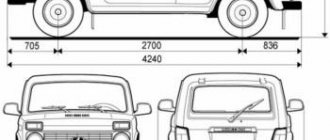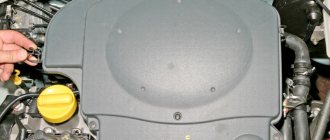Trends in the modern automotive market require the release of models that combine maneuverability and excellent cross-country ability. One of these cars was the new all-wheel drive Largus. A modified station wagon with crossover characteristics has won one of the leading positions in the ratings, making it into the top ten popular cars a few months after the official start of sales.
General information
In February 2015, sales of the new domestic car Lada Largus Cross successfully started. Its technical characteristics exceeded many, even the wildest expectations. The new product was liked by the owners who managed to purchase this car. The main version of the car is built on the B0 platform and is based on the good old Reno Logan. The car differs from its classmates not only in price, but also in some other data. The suspension has an excellent safety margin, and allows for operation not only on good asphalt, but also in severe off-road conditions. The ground clearance increased to 260 millimeters (at the level of the bumper) allows you to avoid all kinds of damage to the paint coating. Plastic linings perfectly protect the bottom. When traveling on country roads, the risk of damage to the lower part is minimized.
The configurations of the Lada Largus cross are also pleasing. Initially, it is supplied in the “standard” version, but is fully equipped: ABS, driver and passenger airbags, air conditioning, heated seats, electric mirrors, a tape recorder, fog lights, power windows, an on-board computer and roof rails.
Me and my brother from the village: what is the difference between Largus and Largus Cross?
Not again, but again! Again we consider obvious topics, because for some they are obvious, but for others they are relevant. Let's find out how Largus Cross differs from regular Largus. Automotive pros and experts, close the tab and better read something else on Kolesa.ru - for example, about the Hungarian auto industry during socialism, which you probably don’t really know anything about. Mere mortals, move closer to the monitors.
Appearance
The appearance of the car is extremely similar to the old Lada Largus, which is not surprising. The changes present, as mentioned above, are plastic body kits that protect the bumper and underbody. Another change that immediately catches your eye is the 16-inch wheels. This allows the car to feel much more confident on the road. In this case, the tire size is 205x55x16. The distance from the standard tires to the arch is 70 millimeters, which is 10 millimeters more than that of a regular LadaLargus. The disadvantages include the lack of any protection for the gas tank flap. The standard design does not provide a lock. In appearance, I would like to note the branded VAZ optics and fog lights hidden in the bumper. The car has excellent visibility, which is important on our roads.
The design of the rear doors is simply ideal for a car in this class. We must give credit to the French, because this is precisely their improvement. Fully open doors create a huge opening. The car can be five or seven-seater, while the third row of seats is completely retractable. And if you fold out all the seats, you get a huge station wagon. That is why the model is positioned not only as a family car, but also as a vehicle for small businesses. With the third row of seats folded down, the trunk volume increases to 700 liters, and if everything is folded down, it increases to an impressive 2350 liters. For lovers of hunting and fishing, the car will be simply irreplaceable: if desired, you can get two full-fledged sleeping places.
Trunk
Since the car has three rows of seats, there is little space left for the trunk. But, if you fold back the back rows, the volume will be 550 liters.
In terms of execution, everything is simple, on the sides there are mesh for securing luggage. A road tool is attached to the right. In general, the Lada Largus is a very practical car, it has a low loading height and a huge opening.
For greater loading convenience, the doors can be disengaged from their stops, providing even more space.
I believe that Largus, for its price, is a top-end B-class minivan that has no analogues. Be sure to write in the comments what you think of Largus’ new appearance and whether the changes have benefited him.
Salon and interior decoration
The car's interior has been noticeably redesigned. Pleasant orange piping is located on the center console and as inserts on the doors. The instrument panel is also illuminated in orange. The seats are quite well stitched with stitching and have a convenient adjustment mechanism. The seat cushions are made to fit the shape of your back. The salon will seem familiar to fans of the French automobile industry, which is not surprising. There are a number of issues with ergonomics, for example, the window lift buttons are located on the center console, which may seem inconvenient. However, this is a matter of habit. I would like to note that, in general, for a car of this class the interior looks light and fresh. An interesting feature is a shelf for second-row passengers, which can accommodate many small items.
Exterior changes
The all-wheel drive Largus has been restyled, affecting mainly the front part of the car. The off-road profile was achieved through the applied facelift technologies:
- Side plastic body kits and inserts on wheel arches made of durable plastic protect the body from chips and scratches.
- Updated design of the radiator grille with the AvtoVAZ logo placed on it.
- 16-inch alloy wheels that improve the stability and handling of the crossover.
- New front bumper design and angular body lines.
Chassis and engine
So far, the Lada Largus cross is available only in a front-wheel drive version, so it cannot pretend to be a full-fledged SUV. The engine is a 4-cylinder, with 16 valves and a volume of 1.6 liters. The maximum power of the car is 105 “horses”, which it will develop at 5750 rpm. When the car is fully loaded, the dynamics remain at a fairly high level, however, miracles do not happen and the 1.6-liter engine makes its presence felt.
The gearbox is five-speed, gears are engaged clearly and confidently. There are no questions about this car. In the future, it is planned to release Larguscross with an automatic transmission, but for now we have to be content with what we have.
European engineers were involved in the development of the chassis. This car was equipped with the “indestructible” RenoLogan suspension, which in the end turned out to be the right decision. At the same time, the shock absorbers were lengthened and different springs were installed. This made it possible to maintain maneuverability. 12 Despite the overall length of the car (4470 mm), the car does not roll when cornering and there is still room for maneuver even during sudden lane changes. In general, the suspension is quite rigid, which allows you to “jump” over potholes. Although it should be noted that the dynamics are still lacking, we should not forget that this is still a domestic car. By the way, some people get out of this situation by modifying the throttle, increasing the passage opening. It is worth saying that this modification is dubious and reviews vary greatly from laudatory to complete dissatisfaction. It makes sense to do this only if the car will be used exclusively in the urban cycle; there is an opinion that at speed the car stops “pulling”.
There are minor complaints about the braking system. The car does not always respond adequately to the brake pedal. I would like to get more responsiveness when pressing this pedal.
A rare case for a budget station wagon, especially a Russian-made one - nothing rings or rattles in the cabin, the rear part of the cabin does not live its own life.
The engine is almost inaudible when driving. Overall, the sound insulation of this car leaves a pleasant impression. Fuel consumption in the combined cycle is about 10 liters per 100 kilometers. In principle, the result is not bad, although it could be lower. The manufacturer recommends refueling with gasoline of a quality no less than AI-95, which will undoubtedly affect the cost of maintenance.
Motor
The eight-valve engine has been extensively modified, it contains 48 new and modernized parts. We went through everything: piston and valve groups, camshaft and crankshaft, throttle pipe and fuel rail. Even the spark plugs are different, with M12 threads instead of M14.
Plus three horses and three Newton meters to the previous engine - a so-so increase. But there are other benefits too. Urban gasoline consumption has become 200-300 ml per 100 km lower, the engine is now quieter by an average of 2.4 dB - and this is a big difference! The main thing: the guaranteed resource has increased from 160 thousand to 200 thousand km.
The first check of valve adjustment is now required at 90,000 km. On the previous engine, this was done first at 2000 km, and then every odd maintenance. Hydraulic compensators did not appear, but the engineers abandoned the washers. Now there is only a solid pusher in the valve drive.
VAZ employees have calculated approximate savings from the new engine: about 2,900 rubles per 20 thousand km on gasoline and 2,000 rubles due to the refusal to adjust the valves every second service.
I do not believe in all the promised benefits at word. Two examples. The VAZ team tortured the 1.8 engine for a very long time. And they produced a unit with a tendency to consume oil (it had to be modified). And on editorial Vesta the other day the impeller of the pump fell apart at a mileage of 108 thousand km. Of course, it must be changed together with the timing drive kit, for which a service life of 180 thousand km is stated. What's the point of having such a safety margin on the belt if the water pump still needs to be replaced twice as soon?
I liked the base 90-horsepower engine even more than the 16-valve 106-horsepower engine. But under heavy load it will, of course, turn sour.
Safety
No one hides the fact that, in essence, the Lada Larguss cross is the heir to the French RenoDacio. The car has excellent prospects on the Russian market: it is very practical, roomy, with an excellent interior and a good chassis. Of course, there are options for modernization. In the future I would like to see an all-wheel drive version, a more powerful engine, an “automatic” or “robot”. It wouldn't hurt to work on safety, too. In crash tests, overall driver safety was rated three points. In a frontal impact at a speed of 64 km/h, the driver's legs are at greatest risk; the airbag, on the contrary, does an excellent job and completely protects the head. The situation is much worse with a side impact. Due to weak lateral protection, there is a very high chance of breaking ribs. EuroNcap gave the car three out of five stars. If we evaluate safety using other methods, taking into account penalties, then Largus cross is unlikely to get even two stars. So we can say that this car is by no means a safety standard.
Interior
Official dealers, as we have already said, offer the Lada Largus Cross for 5 seats and for 7 seats. The interior layout is in many ways reminiscent of the universal version of the crossover, equipped with comfortable wide seats, ergonomic controls and additional shelves for small items.
Changes in the interior design are visible to the naked eye: leather inserts in bright colors have appeared on the center console and door panels, all seats are equipped with comfortable headrests. There are three-point seat belts. The design of the driver's seat is equipped with lumbar support. The steering wheel can be adjusted to its maximum vertical position.
The safety system of the all-wheel drive Largus is similar to that on European cars and is represented by airbags for the driver and front passenger, and side airbags that protect against injury in the event of a frontal collision.
Specifications
| Engine | 1.6 l 16-valve, 102 hp |
| Wheel formula | 4 x 2 with front wheel drive |
| Engine location | transverse |
| Body type | station wagon, 5 doors |
| Length | 4470 mm |
| Width | 1756 mm |
| Height | 1682 mm |
| Base | mm 2905 |
| Front and rear wheel track | 1461 and 1466 mm |
| Luggage compartment volume in passenger and cargo versions | 560 and 2350 liters |
| Engine | petrol, electronically controlled fuel injection |
| Working volume | 1598 cm/cube |
| Maximum power | 102 hp at 5750 rpm |
| Maximum torque | 145 Nm at 3750 rpm |
| Fuel | AI-95 and higher |
| Maximum speed | 165 km/h |
| Acceleration to hundreds | 13.1 s |
| Consumption | in the city 11.5 liters per hundred, outside the city 7.5 liters, combined cycle - 9.5-10 liters |
| Weight | from 1260 to 1345 kg |
| Maximum weight | 1790 kg (fully loaded) |
| Volume of the tank | 50 liters |
| Transmission | mechanical, five stages with final drive number 4.2 |
| Front suspension | independent, spring |
| Rear | semi-independent, lever |
| Tires | Dimension 205/55 16 inches |
The price of a five-seat crossover as of December 2015 is from 616,000 thousand rubles, and the seven-seat version costs 641,500 rubles;
Comfort of movement
Regardless of the price and configuration, the Lada Largus Cross 4x4 is equipped with an independent front suspension and a semi-independent rear suspension, which ensures the comfort of the crossover:
- Elimination of outside noise while driving.
- Smooth ride when driving on uneven road surfaces.
- Increased passability on country roads.
- Maintains excellent handling and maneuverability in urban areas.
The reinforced body and frame increase the level of safety when driving at high speed.
Manual transmission TL8, 6 speed.
This transmission was developed on the basis of the TL4 and was intended for 4X4 Renault-Nissan models.
A hydraulic clutch drive, two flexible control cables, a twin-shaft system and synchronizers in all gears, including reverse - this is the design of the TL8. The driveshaft is connected through a gearbox and transmits torque to the rear axle. All-wheel drive is activated from inside the cabin when the switch closes the electromagnetic clutch.
The TL8 is equipped with engines developing up to 240 Nm of torque. Among the features is a short first gear, which owners often use as a reduction gear when off-road.
The resource of TL8 is about 150 thousand, and this, of course, is not much. But if you change the oil every 60 thousand and do not participate in off-road racing, you can actually extend the life of the unit by 2-3 times.
As for characteristic malfunctions, the TL8 sometimes howls spontaneously, according to complaints from owners. There are also oil leaks through seals and gaskets. There have been cases of transmission destruction at ridiculous mileage, but, as a rule, they are associated with gross errors during assembly at the factory, such as underfilling the unit with oil.
- The three most reliable Renault engines, read
- 3 most unsuccessful Renault engines, read.
Cargo dimensions
The restyled version of the all-wheel drive Largus is available in two versions - five- and seven-seater, differing in the interior layout and luggage compartment volume. Folding seats allow you to quickly transform the seven-seater model into an all-terrain station wagon with all-terrain capability and spaciousness. The crossover is equipped with powerful roof rails and an additional luggage basket. The ability to load large items is available thanks to the hinged rear doors.
The five-door design greatly facilitates access to the cabin for third-row passengers. The cargo model of the all-wheel drive Largus allows you to load items through the side door.
JH3 and JR5 gearbox
Depending on the configuration, the car is equipped with five-speed JH3 and JR5 gearboxes, made according to a two-shaft design with synchronizers for all forward gears and combined with a differential and final drive. Transmission fluid is poured into the gearbox at the factory, which is designed for the entire service life of the vehicle. Therefore, there is no need to change the gearbox oil according to maintenance schedules.
Gearbox JH3: 1 — rear gearbox cover; 2 — clutch cable bracket; 3 — clutch fork; 4 — gearbox housing; 5 — breather fitting; 6 — gear shift mechanism; 7 — cavity for the speed sensor; 8 — shaft of the right side differential gear; 9 — clutch housing; 10 - input shaft; 11 — boot; 12 — holder for electrical wires; 13 — oil filler cap; 14 — housing of the internal hinge of the drive mechanism of the left wheel; 15 - reverse light switch
The car engine, like all internal combustion engines, develops power and torque in a relatively narrow speed range. As engine speed decreases, power decreases
The power transmission allows you to reduce the number of revolutions of the drive axle in relation to the number of revolutions of the engine crankshaft, increasing traction force. The higher the traction force, the lower the speed.
When driving a car, it becomes necessary to use different speeds and different traction forces. For example, when driving through deep sand, the speed is insignificant, and a fairly large traction force is required to overcome the resistance of the road. Great traction force is also required when starting the car and overcoming steep inclines. On the contrary, when driving on a paved road, little traction is required, but the speed of movement can be high.
To increase or decrease the traction force on the drive axle while maintaining a constant torque on the engine shaft, a gearbox is used in the vehicle's power transmission.
Due to the fact that the engines of different car models have different power, then, of course, the gear ratios of individual gears, and, consequently, the number of teeth of the gears are different. However, the operating principle of the gearboxes is the same, and the disassembly, assembly and repair operations are generally similar.
The purpose of the gearbox is to ensure further conversion of torque in magnitude and direction in accordance with the load on the vehicle, as well as to enable the engine to idle.
The basic principle of operation of the gearbox is the same everywhere, the essence of which is the pairwise connection of gears that have a different number of teeth. In this case, the torque transmitted by the gears changes in proportion to the gear ratio, i.e. The ratio of the number of teeth on the driven gear to the number of teeth on the drive gear.
A gearbox is, in principle, a very simple device.
Gearbox control mechanism: 1 – bushing (the gearbox control rod is connected to it); 2 – gearbox lever retainer; 3 – gear shift lever (has a ball bearing that is inserted into the body); 4 – lever handle; 5 – plastic body
Gearbox control rod: 1 – coupling bolt; 2 – clamp; 3 – nut; 4 – traction; 5 – traction finger
The rod is attached at one end to the bushing of the gearbox control mechanism, and at the other end to the shift mechanism installed on the gearbox.
Gearbox JR5
Gearbox JR5: 1 — input shaft; 2 — right wheel drive oil seal; 3 — clutch housing; 4 — gearbox housing; 5 — back cover; 6 — breather fitting; 7 — eye-bracket; 8 — gear lever; 9 — gear selection lever; 10 — speed sensor or plug; 11 — bracket for fastening transmission control cables; 12 — left wheel drive oil seal; 13 — reverse light switch; 14 — oil filler cap; 15 — tube for supplying fluid to the working cylinder of the hydraulic clutch; 16 — clutch release bearing
What gearboxes are installed on the Lada-Largus
In general, all internal combustion engines (ICEs) have the same drawback - insufficient adaptability to vehicle operating modes. The internal combustion engine is capable of developing power and torque in a small crankshaft speed range. Moreover, with a decrease in the number of revolutions, the developed power decreases.
During operation, the car moves at different speeds and requires varying torque. For example, when starting from a stop, the speed of the car is low, but the traction force must be large. On the contrary, when moving on a good road, the car develops high speed without requiring much traction force.
In order to ensure a change in the magnitude and direction (reverse movement) of the torque at constant power of the power unit within a wider range, a gearbox is used. In addition, with the help of a gearbox, the engine and drive wheels are disconnected for an unlimited time and, unlike the clutch, without the participation of the vehicle driver.
Gearbox for LADA Largus
The LADA Largus station wagon (2012 - present) is positioned by the manufacturer as a multifunctional car and is offered to potential buyers in three body styles:
- 5-seater passenger;
- 7-seater passenger;
- 2-seater cargo van.
Moreover, it can be used both as a family and commercial vehicle.
Depending on the configuration, LADA Largus engines are equipped with one of two identical 5-speed manual transmissions:
- JH3 – 5-seater passenger cars equipped with a K7M engine.
- JR5 - station wagons (passenger and cargo) in all other trim levels.
Both boxes are adapted to work in difficult climatic and road conditions characteristic of Russia and the CIS countries.
Important! During assembly, transmission oil is poured into the crankcase, which is designed for the entire service life of the LADA Largus vehicle. In this regard, during maintenance and routine maintenance, an oil change is not required.
Gearbox device
The operating principle of all manual gearboxes is almost the same and consists of pairwise connection of gears with different numbers of teeth. Its task is to ensure a change in torque proportional to the gear ratio. At the same time, different car engines have different power, which forces designers to calculate gear ratios and the number of teeth on gears for each model separately.
Reference! The gear ratio is the ratio of the number of teeth of the driven/drive gears.
The table of gear ratios of the gearbox of the LADA Largus car is given in the table:
The design of the gearbox that powers the power units of the LADA Largus station wagon is almost the same. It is based on a two-shaft circuit with synchronizers for all forward gears. This scheme provides for the presence of two parallel shafts, one of which is driving, and the second is driven. During operation, torque from the input shaft gear is transmitted to the desired secondary shaft gear, which is fixed by a synchronizer. A twin-shaft gearbox can have 4 or more forward gears. The principle of its operation is demonstrated in the video:
The main advantage of the two-shaft design is the possibility of constructively combining the engine and transmission into a compact power unit. However, when implementing such a scheme, it is technically impossible to implement direct transmission, which limits its use in heavy vehicles. It is used in front- and rear-wheel drive passenger cars or heavy motorcycles.
Differences between JH3 and JR5 gearboxes
Despite the structural similarity, the gearboxes of the LADA Largus station wagon have a number of significant differences. In addition to different gear ratios, they are organized differently:
- drive wheel drive connections;
- speed selection;
- disengaging the clutch;
- connection of driving wheels.
Clutch on/off unit:
- The clutch in the JH3 gearbox is engaged/disengaged using a clutch with a bearing, which is moved by a special fork along a guide sleeve. In this case, the latter is connected by a cable to the clutch pedal.
- In the JR5 gearbox, the process of engaging/disengaging the clutch is carried out by a working hydraulic cylinder combined with the clutch release bearing. The working cylinder is connected to the main hydraulic cylinder by a separate pipeline. The clutch pedal acts on the master cylinder rod.
The speed selection in the JH3 gearbox is controlled by a rigid rod, while in the JR5 it is controlled by two flexible cables.
Checkpoint identification
The type of specific gearbox installed on the LADA Largus engine is indicated on a special plate located on the lower part of the crankcase. The plate contains the following information:
- gearbox type - JH3 or JR5;
- gearbox modification;
- factory number;
- manufacturer code.
Gearboxes manufactured at:
- PJSC "AvtoVAZ" - the letter "P";
- to a third party - with the letter “A”.
- Types of transfer cases, malfunctions
- What is the difference between an automatic transmission and a robot?
- Automatic transmission - how to use correctly
- Adaptation of the Easytronic Opel grip point
Transmission
Front-wheel drive 5-speed manual transmission.
- front: spring, independent;
- rear: spring, semi-independent.
The body of the 5-door station wagon Lada Largus Cross 4x4 with a width of 1756 mm has a length of 4470 mm with a number of seats for 5-7 people, including the driver. The height of the car is 1682 mm. The useful volume of the luggage compartment varies from 135 mm to the maximum possible 2350 mm. With a wheelbase of 2905 mm, the front track differs from the rear by 5 mm (1461 mm and 1466 mm, respectively).

